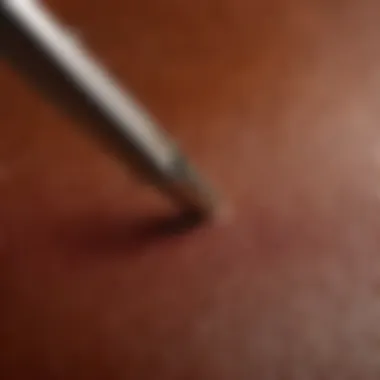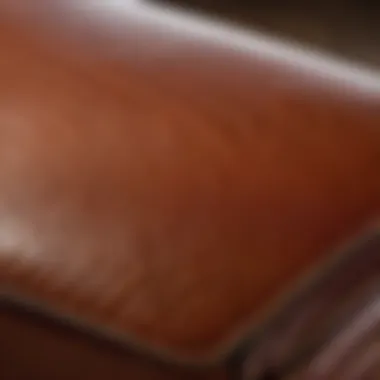Materials:
- Leather stitching awl: 1 piece (measuring 5.5 inches)
- Wax-coated thread: 1 spool (70 yards)
- Leather sewing needles: 2 needles (size 18)
- Stitching groover: 1 piece
- Leather glue: 1 bottle (4 oz)
DIY Steps:
- Assess Seam Damage: Begin by inspecting the affected area for loose stitches or tears.
- Prepare Leather: Clean the area around the seam using a damp cloth and allow it to dry completely.
- Thread Selection: Cut a suitable length of wax-coated thread and thread the leather sewing needle.
- Repair Technique: Use the stitching awl to carefully restitch the seam, ensuring tight and even stitching.
- Sealing: Apply a thin layer of leather glue along the repaired seam for added reinforcement.
Technical Aspects:
- Timing: Plan for approximately 30-60 minutes for a medium-sized repair.
- Tools: Ensure a well-lit work area and have a sturdy surface to support the leather work.
- Techniques: Master the saddle stitch for durable and aesthetically pleasing results.
DIY Project Process:


- Start by assessing the damage and planning your repair approach.
- Clean the leather thoroughly to ensure a strong bond with the glue.
- Use precision and steady hand movements when sewing to avoid further damage.
- Troubleshooting Tips: If stitches appear uneven, consider practicing on scrap leather before proceeding with the repair.
Understanding Leather Seam Repair


Leather seam repair is a crucial aspect of maintaining your leather goods and ensuring their longevity. In this insightful guide, we delve deep into the significance of understanding leather seam repair, shedding light on various techniques and tips to assist you in reviving your prized possessions.
Importance of Quality Craftsmanship
Craftsmanship plays a pivotal role in the durability and appeal of leather goods. The art of leatherworking embodies meticulous attention to detail and superior skill, resulting in well-crafted products that stand the test of time. In this article, we emphasize the essence of quality craftsmanship in leather seam repair, highlighting how the mastery of leatherworking enhances the overall repair process. The intricate nature of leatherworking ensures precise stitching and structural integrity, essential for seamless repairs and restoring leather items to their former glory.
Significance of Proper Seams
Proper seams are the backbone of leather products, dictating their strength and resilience. Understanding the significance of proper seams is paramount in effective leather seam repair. By employing sturdy and well-executed seams, you guarantee the longevity of your repaired items. Proper seams contribute to the structural integrity of leather goods, preventing further damage and enhancing their overall aesthetic. With a focus on proper seams, this guide empowers you to deliver professional-level repairs and maintain the quality of your beloved leather possessions.
Common Causes of Seam Damage
Seam damage can result from various factors, with wear and tear being a prevalent issue. Daily use and exposure to elements can lead to weakened seams, compromising the integrity of leather products. Additionally, inferior stitching techniques contribute to seam damage, resulting in unraveling and fraying. It is essential to address these common causes of seam damage promptly to prevent further deterioration of your leather items.
Tools and Materials
When delving into leather seam repair, having the right tools and materials is indispensable. Needles and thread are essential components, allowing you to seamlessly stitch and reinforce seams. Their durability and compatibility with leather ensure sturdy repairs that withstand the test of time. In addition, leather glue serves as a versatile tool for bonding seams and enhancing the structural stability of repaired areas. By understanding the importance of these tools and materials, you equip yourself with the necessities for successful leather seam repair. Maintaining the quality of your leather goods becomes achievable with the utilization of these tools and materials.
Preparation for Repair


When it comes to reviving your leather goods, proper preparation for repair is crucial to ensure a successful outcome. A well-thought-out preparation phase sets the foundation for the repair work that follows, ultimately determining the longevity and effectiveness of the repair. In this article, we delve into the significance of meticulous preparation, focusing on specific elements that housewives and house owners should consider before embarking on leather seam repair. By carefully assessing the damage, cleaning the leather, and securing the work area, individuals can set themselves up for a seamless repair process that yields optimal results -- ultimately saving money and preserving beloved leather items for years to come.
Assessing the Damage
Inspecting Seam Integrity
Inspecting seam integrity is a critical step in the preparation phase of leather seam repair. This process involves a detailed examination of the seams to identify any weaknesses, tears, or loose stitches that may compromise the overall integrity of the leather item. By meticulously inspecting the seam integrity, individuals can pinpoint areas that require immediate attention, ensuring a thorough and effective repair process. This meticulous inspection allows for the identification of underlying issues, preventing potential future damage and ensuring the longevity of the repair.
Identifying Stitching Issues
Effective repair hinges on accurately identifying stitching issues within the leather seams. Whether it's uneven stitching, fraying threads, or missing stitches, recognizing stitching issues is essential for a successful repair outcome. By honing in on these specific problems, individuals can address them strategically, choosing the appropriate repair techniques and materials. This detailed identification process sets the stage for targeted repair work, ensuring that each stitching issue is adequately resolved to restore the leather item to its former glory.
Cleaning the Leather
Use of Gentle Cleaners
Utilizing gentle cleaners is paramount in the leather cleaning process, as harsh chemicals can potentially damage the material. Gentle cleaners help remove dirt, grime, and other surface contaminants without compromising the integrity of the leather. By opting for mild and gentle cleaning solutions, individuals can effectively cleanse their leather goods without causing any unintended harm. This careful approach not only safeguards the leather's quality but also prepares it for the subsequent repair work, ensuring optimal adhesion of stitching and adhesives.
Avoiding Harsh Chemicals
Steering clear of harsh chemicals when cleaning leather is pivotal to preserving its texture and appearance. Harsh cleaners can strip the leather of its natural oils, leading to dryness, cracking, and deterioration over time. By avoiding harsh chemicals, individuals can protect their leather goods from unnecessary damage and extend their lifespan. This emphasis on using gentle and leather-safe cleaning products underscores a commitment to responsible leather care, ensuring that the cleaning process contributes positively to the overall repair outcome.
Securing the Work Area
Flat Surface Requirement
A flat surface is a non-negotiable requirement when undertaking leather seam repair. A stable and level workspace provides the necessary foundation for executing precise repair work, ensuring that the leather item is positioned securely during the repair process. By adhering to this flat surface requirement, individuals can work with confidence and accuracy, minimizing the risk of errors or uneven stitching. The flat surface serves as a reliable platform for focusing on intricate repair tasks, enhancing both the efficiency and quality of the repair process.
Proper Lighting
Proper lighting is a fundamental aspect of securing the work area and facilitating detailed repair work. Adequate lighting illuminates the repair space, allowing individuals to detect subtle imperfections in stitching and ensure proper alignment of seams. By investing in quality lighting fixtures or positioning the work area near natural light sources, individuals can enhance visibility and precision during the repair process. This emphasis on proper lighting not only streamlines the repair work but also elevates the overall quality of the finished repair, showcasing meticulous attention to detail and craftsmanship.
Executing the Repair
When it comes to reviving your leather goods, executing the repair process is a crucial step in ensuring the longevity and functionality of your items. This section delves into the intricate details of repairing leather seams, emphasizing the precision and care required to achieve optimal results. From hand stitching techniques to utilizing leather adhesives, each aspect of the repair plays a vital role in restoring your leather possessions to their former glory.
Hand Stitching Techniques
Hand stitching techniques are a cornerstone of leather seam repair, offering a meticulous approach to securing seams with high durability. In this section, we will explore the intricacies of two popular hand stitching methods - the Saddle Stitch Method and the Running Stitch Approach.
Saddle Stitch Method
The Saddle Stitch Method stands out for its exceptional strength and resistance to unraveling, making it a top choice for enhancing the durability of leather seams. Its key characteristic lies in the use of two needles simultaneously, creating interlocking stitches that provide superior structural integrity. The unique feature of this method is its ability to prevent stitches from coming undone if one thread breaks, ensuring long-lasting repair solutions for your leather goods.
Running Stitch Approach
Contrasting the Saddle Stitch Method, the Running Stitch Approach offers simplicity and efficiency in securing leather seams. Its key characteristic involves a single needle passing through the leather in a continuous line, providing a quicker alternative for seam repairs. While not as inherently strong as the Saddle Stitch, this method's advantage lies in its ease of use and suitability for achieving neat, straight stitches on leather surfaces.
Using Leather Adhesives
Incorporating leather adhesives into the repair process can significantly enhance the bond between seams, establishing a reliable and long-lasting fix for your leather items. Within this section, we will discuss the importance of Application Tips and the Bonding Strength of these adhesives.
Application Tips
Effective application of leather adhesive is paramount for ensuring a seamless and durable repair. The key characteristic of application tips lies in the methodical spreading and positioning of adhesive along the seam, optimizing adhesion and minimizing excess glue overflow. This meticulous approach enhances the overall quality of the repair, promoting a robust and aesthetically pleasing outcome.
Bonding Strength
The bonding strength of leather adhesives plays a pivotal role in securing seams with enduring adhesion. Its key characteristic involves creating a strong and flexible bond between leather surfaces, ensuring long-term durability. The advantage of superior bonding strength lies in its ability to reinforce seams effectively, preventing future unraveling or separation, thereby prolonging the life of your repaired leather items.
Finishing Touches
After executing the repair process with precision and care, finishing touches serve as the final steps in enhancing the aesthetic appeal and durability of your leather goods. This section will focus on Trimming Excess Thread and Polishing the Leather to complete the restoration process.
Trimming Excess Thread
Precision trimming of excess thread is essential to achieving a clean and professional finish to your leather repair. The key characteristic of this task lies in meticulously cutting off any surplus thread, ensuring a seamless and polished look to the repaired seam. This meticulous approach enhances the overall appearance of your leather item, showcasing attention to detail and quality craftsmanship.
Polishing the Leather
A critical step in the restoration process, polishing the leather not only enhances its visual appeal but also provides protection and conditioning. The key characteristic of polishing involves applying quality leather polish in smooth, even motions to achieve a lustrous finish. The advantage of this process is that it nourishes the leather, making it more supple and resistant to wear and tear, prolonging the lifespan of your repaired item.
Post-Repair Care
Post-repair care is a crucial aspect when it comes to maintaining the longevity and quality of your leather goods. After undergoing the meticulous process of leather seam repair, it is essential to implement effective post-repair care routines to ensure that your items stay in optimal condition for an extended period. By dedicating time and effort to post-repair care, you can preserve the beauty and functionality of your beloved leather possessions.
Preservation Techniques
Conditioning the Leather
Conditioning the leather is a fundamental practice that plays a significant role in post-repair care. This process involves nourishing and moisturizing the leather to prevent it from drying out and becoming brittle. Conditioning helps maintain the suppleness and shine of the leather, contributing to its overall appearance and feel. A key characteristic of conditioning is its ability to rejuvenate and revitalize the leather, keeping it soft and preventing cracks or damage. Opting for high-quality leather conditioners ensures that your repaired seams and the surrounding areas are adequately hydrated, promoting durability and resistance to wear and tear.
Storage Recommendations
Proper storage is another essential component of post-repair care. Storing your leather goods correctly can prevent unnecessary damage and prolong their lifespan. When considering storage recommendations, it is vital to shield your items from excessive sunlight, moisture, and temperature fluctuations. Implementing these recommendations safeguards your repaired leather seams from environmental factors that could compromise their integrity. A noteworthy feature of ideal storage solutions is their ability to maintain the structural integrity of the leather, preventing warping or distortion over time. By following appropriate storage practices, you can safeguard your repaired leather items and ensure they remain in pristine condition.
Regular Maintenance
In addition to post-repair care, regular maintenance routines are imperative for sustaining the quality and aesthetics of your leather goods. By adhering to consistent maintenance practices, you can prevent the recurrence of seam issues and enhance the overall appearance of your cherished belongings. Incorporating cleaning guidelines and periodic inspections into your maintenance schedule promotes the longevity of your repaired leather items and preserves their timeless allure.
Cleaning Guidelines
Cleaning guidelines are a fundamental aspect of routine maintenance for leather goods. By following specific cleaning procedures using mild solutions and soft cloths, you can effectively remove dirt, stains, and debris without causing harm to the leather. A key characteristic of cleaning guidelines is their ability to refresh and revive the appearance of the leather, keeping it looking lustrous and clean. Implementing these guidelines regularly ensures that your repaired seams remain free from contaminants that could compromise their finish and quality.
Periodic Inspections
Periodic inspections serve as a proactive measure to identify any potential issues or wear on your leather goods. By conducting thorough inspections at regular intervals, you can detect early signs of damage or deterioration, enabling prompt action to be taken. The key characteristic of periodic inspections is their ability to prevent minor concerns from escalating into larger problems, ultimately saving you time and effort in the long run. Performing these inspections allows you to address any emerging issues promptly and maintain the structural integrity of your repaired leather items.
Troubleshooting Tips
Troubleshooting tips hold a crucial role in the comprehensive guide to leather seam repair as they provide valuable insights into resolving challenging seam issues effectively. In this article, the Troubleshooting Tips section aims to equip readers with practical strategies to overcome stubborn seams, ensuring a successful leather restoration process. By delving into specific elements such as reinforcement strategies and seeking professional help, this segment adds depth and expertise to the overall repair methodology.
Dealing with Stubborn Seams
Reinforcement Strategies
Reinforcement strategies play a pivotal role in strengthening leather seams, contributing significantly to the desired outcome of seam repair projects. The key characteristic of reinforcement strategies lies in their ability to fortify vulnerable seams, enhancing the overall durability and longevity of the repaired area. In this article, these strategies are highlighted for their effectiveness in addressing challenging seam issues, providing a reliable solution for seam damage. The unique feature of reinforcement strategies lies in their versatile application, offering a tailored approach to each seam repair scenario. While presenting advantages such as enhanced seam resilience, there might be slight drawbacks, such as potential stiffness in the repaired area. Nonetheless, in the context of this article, reinforcement strategies stand out as a beneficial choice for ensuring successful leather seam restoration.
Seeking Professional Help
In the realm of leather seam repair, seeking professional assistance can significantly contribute to overcoming complex seam challenges. The key characteristic of engaging professional help lies in accessing specialized expertise and precision craftsmanship, which can elevate the quality of seam repairs. Professional help is deemed a popular choice for individuals seeking flawless results and intricate detailing in their leather goods restoration efforts. The unique feature of professional assistance lies in the assurance of skillful precision and comprehensive solutions tailored to each seam's specific requirements. While the advantages of seeking professional help include impeccable results and expert guidance, a potential disadvantage could be the additional cost incurred. Nevertheless, in the context of this article, seeking professional help emerges as a prudent choice to navigate through tough seam repair situations with finesse.
Avoiding Common Mistakes
Overdoing the Stitching
Overdoing the stitching can have a significant impact on the overall outcome of leather seam repair projects within the context of this comprehensive guide. The key characteristic of this aspect lies in the delicate balance between adequate stitch reinforcement and excessive stitching that may compromise the leather's integrity. Highlighted for its potential to either enhance or detract from the repair process, overdoing the stitching can be a beneficial choice when done judiciously. The unique feature of this approach is its capacity to provide additional strength to weakened seams; however, an excessive application of stitches may lead to bulkiness or stiffness along the repaired area. Despite this, in this article, overdoing the stitching is presented as a cautious yet effective method for reinforcing leather seams.
Excessive Glue Application
The careful consideration of proper glue application is paramount in successful leather seam repair, particularly concerning the aspect of excessive glue application within the scope of this guide. The key characteristic of this aspect underscores the importance of precise and measured glue usage to avoid potential issues such as adhesive seepage or unsightly residue. Noted for its potential to secure seams effectively, excessive glue application can be a beneficial choice when applied judiciously. The unique feature of such an approach lies in its quick bonding strength and seamless seam integration; however, an overly generous application might lead to visible glue marks or hinder the leather's natural flexibility. Despite this, in the context of this article, excessive glue application is presented as a strategic and beneficial method for ensuring sturdy seam repairs without compromising the leather's aesthetic appeal.





